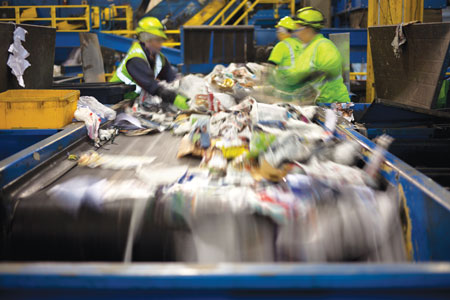Regardless of what happens to recycling goals or their enforcement, or to bans on organic waste from landfills, establishing effective public outreach programs and changing the habits of humans may become a vital component of successful solid waste programs in the near future.
By Jenny Johnson

The banning of organic food waste from landfills is a trend in the U.S. that localities should take notice of today. Six states have organic food waste bans in place to date and they are: California, Massachusetts, Vermont, Connecticut, Rhode Island and New York. While not focused on individual households, these bans are focused on large producers of food waste: cafeterias, hospitals, universities, grocery stores and restaurants. In 2014, Massachusetts banned hospitals, universities and large businesses from sending food waste to landfills. During the same year, a law was passed in California requiring businesses to recycle their organic waste on and after April 1, 2016. In April 2019, New York passed a law requiring diversion of organic food waste from certain businesses that will become effective on January 1, 2022.
The need to reduce the production of greenhouse gases has been the impetus driving this legislation. Instead of being landfilled and contributing to the release of greenhouse gases in the form of methane, organic food waste can be composted (an aerobic process that does not produce methane) or used in anaerobic digestors. Anaerobic digestors produce a biogas that is mostly methane and carbon dioxide. The carbon dioxide can be removed, leaving only methane, which is the primary component of natural gas. The solid material that is left after anaerobic digestion occurs is called digestate, which is nutrient-rich and can be used as fertilizer for crops.
Operational Challenges
As these six states and some select cities work through the operational challenges of establishing an organic food waste management program, they are learning that changing habits of humans is incredibly difficult and that community outreach is an essential component of successful programs.
Similarly, there is a growing need for community outreach by our industry on a national level. While banning food waste from landfills is occurring on a localized basis, recycling programs across the country are facing the immediate need for effective public outreach.
For historical context, this need began when China issued its 2017 National Sword policy and 2018 ban on mixed paper and mixed plastic imports. Unfortunately, the recyclable materials that China was receiving from the U.S. contained contamination (i.e., trash) mixed in with the recyclable materials. Since manufacturers cannot use contaminated raw material, China was required to remove the contamination. As a result, China banned the import of mixed plastics and mixed paper.
Consequently, India emerged as one of the largest importers of recyclable plastic, after the China ban was implemented in 2018. Just a year later, however, India banned plastic import due a lack of sufficient infrastructure to process the new quantity of materials, adding even more stress to recycling programs here in the U.S.

Rethinking Strategies
This stress on the recycling programs initiated the U.S.’s shift in focus away from quantity of recyclables to quality of recyclables. Rethinking the quantity mentality is rife with challenges, and not just those posed by changing the habits of humans. Today, all states must achieve the EPA-established recycling rate of 35 percent (with some exceptions based on population). American Material Recycling Facilities (MRFs) that process curbside recyclables consistently meet quantity requirements, but struggle with consistent quality. This is attributed to the fact that their suppliers are the general public who collectively lack the discipline of the smaller universe of virgin raw material suppliers and industrial scrap dealers.
What’s more, the rise of mandated recycling by EPA shattered the equilibrium between supply and demand that controlled the prices for which the raw materials (i.e., recyclables) would sell. For years, recyclables have flooded the market, regardless of the demand for them.
Today, the onset of COVID-19 has emphasized the need for the general public to understand the economics of recycling, as well as the recycling process. An MRF is designed to sort co-mingled recyclables consisting of paper, cardboard, aluminum cans, bottles, etc. into the individual types of recyclables that can be packaged and shipped to the end user. While much of this sorting is mechanical, people standing in near proximity to one another are needed to remove non-recyclables from the conveyor belts. The non-recyclables cannot be effectively removed by people standing 6 feet or more away from each other. This has resulted in some MRFs closing and collected recyclables being diverted to landfills. Some localities have even halted curbside collection, while others have closed convenience sites where citizens drop off their recyclables.

Prior to COVID-19, localities were considering fee increases to citizens to make up for revenue shortfalls due to limited markets for the ample amounts of recyclable materials. Localities were also facing the reality that they would have to pay for decontamination of materials and/or increasing public outreach to citizens to reduce the contamination of recyclables.
Vital Components
Meanwhile, regulators and legislators have been evaluating the need to reduce the mandatory recycling goals or to relax their enforcement. Thankfully, EPA is not opposed to shifting the recycling priority from quantity to quality. Even so, states and localities may be looking to organic food waste bans as the means by which to achieve the mandated rate if EPA does not relax the recycling rate.
Regardless of what happens to recycling goals or their enforcement, or to bans on organic waste from landfills, establishing effective public outreach programs and changing the habits of humans may become a vital component of successful solid waste programs in the near future.
Reinforcing the Message
Public information campaigns have long been used to change consumer behaviors about waste. During WWII, Americans first began salvaging metal, rubber and even kitchen fat for the war effort. Keep American Beautiful joined the Ad Council in the 1960s to remind Americans not to litter, and in 1970 the recognizable Recycling symbol we still know today was developed by a University of Southern California senior. There has been little nationwide public outreach about the topic since curbside recycling was largely adopted in the 1990s. Individual cities like Seattle and San Francisco have developed campaigns around their legislation to mandate the separation of compostables, which have included fines for non-compliance. The last decade has seen recycling behaviors driven primarily by legislation.
Public information campaigns today face uphill battles with today’s polarized environment. In an age where an opinion (whether or not it is based on facts) can influence thousands of others by a click on Facebook or Twitter, it is important that public information campaigns are crafted by consultants with expertise in the area. Most public information campaigns for public projects or initiatives contain common basic elements: identification and analysis of stakeholders (or stakeholder groups), communications planning and engagement methods (including grievance management). As the driver of consumer behavior related to recycling has changed (during the pre-World War II era, re-use and salvaging was driven by the individual’s desire to receive maximum value from their purchased goods while later, recycling began to be seen as an altruistic behavior), industry messaging has followed suit. To persuade consumers to be more conscientious in their recycling will take an investment in an integrated marketing campaign, with all industry partners engaged in reinforcing the message.
Jenny Johnson is Director of Waste & Recycling for LaBella Associates (Rochester, NY), where she leads civil and environmental engineers, geologists and environmental scientists focused on providing solutions for their waste industry clients. Jenny can be reached at (804) 355-4520 or via e-mail at [email protected].
